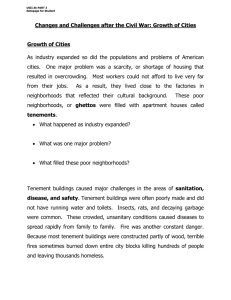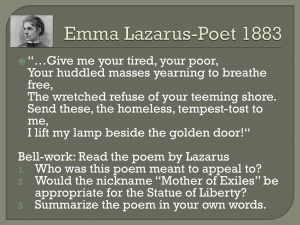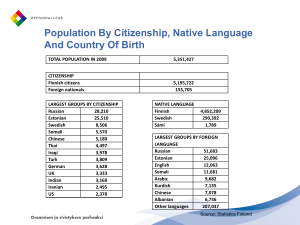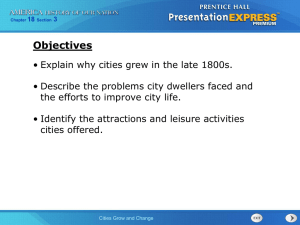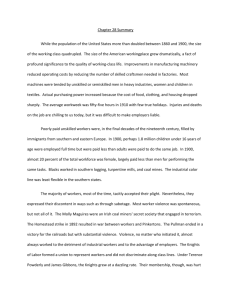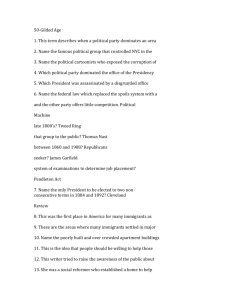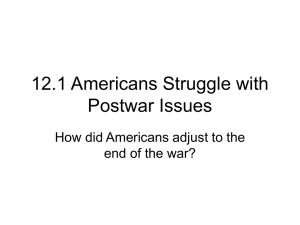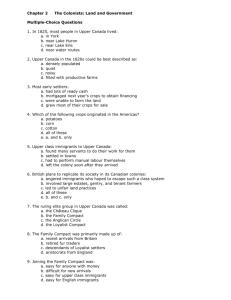The Transformation of Urban American 532 Urban Expansion The
advertisement
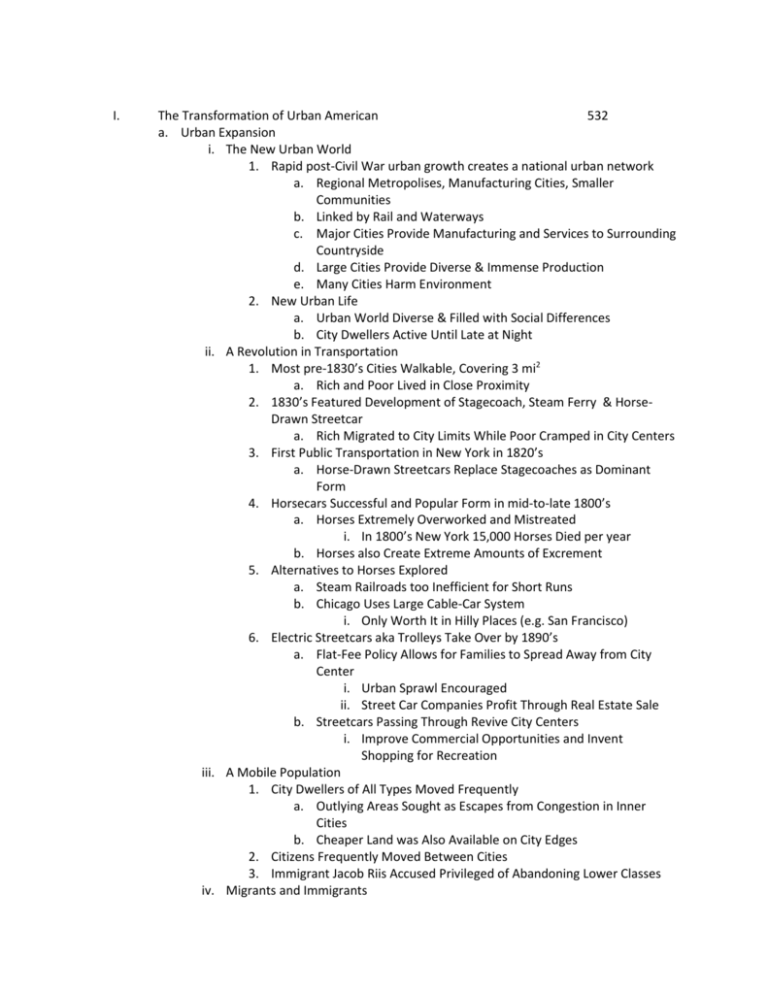
I. The Transformation of Urban American 532 a. Urban Expansion i. The New Urban World 1. Rapid post-Civil War urban growth creates a national urban network a. Regional Metropolises, Manufacturing Cities, Smaller Communities b. Linked by Rail and Waterways c. Major Cities Provide Manufacturing and Services to Surrounding Countryside d. Large Cities Provide Diverse & Immense Production e. Many Cities Harm Environment 2. New Urban Life a. Urban World Diverse & Filled with Social Differences b. City Dwellers Active Until Late at Night ii. A Revolution in Transportation 1. Most pre-1830’s Cities Walkable, Covering 3 mi2 a. Rich and Poor Lived in Close Proximity 2. 1830’s Featured Development of Stagecoach, Steam Ferry & HorseDrawn Streetcar a. Rich Migrated to City Limits While Poor Cramped in City Centers 3. First Public Transportation in New York in 1820’s a. Horse-Drawn Streetcars Replace Stagecoaches as Dominant Form 4. Horsecars Successful and Popular Form in mid-to-late 1800’s a. Horses Extremely Overworked and Mistreated i. In 1800’s New York 15,000 Horses Died per year b. Horses also Create Extreme Amounts of Excrement 5. Alternatives to Horses Explored a. Steam Railroads too Inefficient for Short Runs b. Chicago Uses Large Cable-Car System i. Only Worth It in Hilly Places (e.g. San Francisco) 6. Electric Streetcars aka Trolleys Take Over by 1890’s a. Flat-Fee Policy Allows for Families to Spread Away from City Center i. Urban Sprawl Encouraged ii. Street Car Companies Profit Through Real Estate Sale b. Streetcars Passing Through Revive City Centers i. Improve Commercial Opportunities and Invent Shopping for Recreation iii. A Mobile Population 1. City Dwellers of All Types Moved Frequently a. Outlying Areas Sought as Escapes from Congestion in Inner Cities b. Cheaper Land was Also Available on City Edges 2. Citizens Frequently Moved Between Cities 3. Immigrant Jacob Riis Accused Privileged of Abandoning Lower Classes iv. Migrants and Immigrants 1. Concentrated Good Industrial Jobs in Cities Draws Millions a. Rural Immigration Large Enough to End Some Farm Communities i. Women Can No Longer Perform Farm Labor, Flock to Cities for Jobs Performing Subsistence Tasks b. 10 Million Northern Europeans from 1860 to 1890 i. Germans, English, Scottish, Welsh & Irish ii. 800,000 French-Canadians & 1 Million Scandanavian c. In 1890’s “new immigrants” arrive i. Italians, Slavs, Greeks, Jews from South & Eastern Europe, Armenians, Japanese 2. Mass Immigration Made Possible by New Oceangoing Steamships 3. Very Large Number Settle in North east & North central U.S. 4. Many Came to Improve Economic Situation a. Some to Avoid Economic or Spiritual Problems in Home Country b. Most Families Waited in Home Country for the First Immigrant Member to Send Money to Bring them to America 5. Conditions were Often Very Poor for Immigrants a. Steamship Across Atlantic was Cramped and Unsanitary b. Post-1892 Immigrants Had to be Disease-Free to Enter U.S. c. Often Received Americanized Names 6. Ellis Island (1892) & Angel Island (1910) in New York and San Francisco a. Serve to Process Immigrants and Provide a Place to Set Up Living Arrangements 7. More Wealthy Germans & Scandinavians Travelled to the Midwest Upon Arrival v. Adjusting to Urban Society 1. Immigrants Settled in Ethnically Divided Neighborhoods in Cities a. These Groups Often Subtly Divided into Region; Not Just Nationality b. In 1879, Reformers Pass Law to Improve Quality of Life in Tenements i. New “Dumbbell Tenements” Still Overcrowded 2. Immigrants Maintained Much of the Culture from the Old Country a. British Immigrants Adjusted More Easily and Lived Comfortably b. Large Ethnic Groups Were Also Able to Succeed More Easily i. Smaller Ethnic Groups Had Difficulty Getting Jobs 3. Many Immigrants Had No Intention of Staying in America a. Especially Chinese & Italian Immigrants 4. Immigrants Treated with Increasing Hostility by Native Americans vi. Slums and Ghettos 1. Slums Created When Too Many Residents Packed into Small Areas a. Ghettos Created When Residents Segregated to These Slums b. Many Residents of Slums & Ghettos Italian i. At the Time, Problems Based Largely on Slum Residents 2. Conditions Continued to Worsen in Cities a. Lack of Sanitation Helped Epidemics, Esp. Juvenile, Spread b. Residents Also Dealt with Nearby Industrial Pollution 3. Blacks’ Living Conditions Even Worse a. Lived in Segregated Districts Working for Low Pay b. Rivalry often Sparked Racial Violence, Including Large Riots vii. Fashionable Avenues and Suburbs 1. Wealthy Lived Extravagantly Just Outside of Downtown a. In 1870’s & 80’s Wealthy Moved Farther to Suburbs b. Middle Class Followed as Far as Financially Possible i. Often Lived Along Streetcar Lines 2. Segregation by Income Rapidly Develops 3. Cities in 1900 were Physically and Financially Divided into Separate Neighborhoods and Districts b. The Urban Challenge i. Policing the City 1. Crime Increased Tremendously in Cities a. Horatio Alger wrote Ragged Dick About Various Urban Scams & Tricks b. Increased Violence Caused Concern Over Handgun Access 2. By 1850’s Cities Had Police Forces with Badges, Uniforms & Revolvers a. Often Had Odd Responsibilities (Clean Streets etc.) b. Sometimes Fought Immigrant Gangs c. Did Not Stop Prostitution, Rowdiness etc. Among Immigrants 3. Neighborhood Saloons Offered Cheap Vices a. Non-Immigrant Controlled State Legislatures Tried to Regulate Saloons & Sunday Business Practices b. Police Attempted to Steer Middle Ground 4. NYC Police Found to Be Corrupt in 1894 Report a. Police Accepted Payoffs to Ignore Illegal Vices 5. Police Professionalized in 1890’s ii. Governing the City 1. Politicians Fought For Control Over Lucrative Municipal Departments 2. City Governments & State Legislatures Each Claimed Authority 3. New Urban Political System Emerges a. City “Machines” Attempt to Keep One Party/Faction In Charge i. Headed by “Boss” Who May be Mayor 1. Assisted by Local Ward Captains 2. Familiar With Constituents b. Pyramid Structure i. Precinct Captains Who Reported to Ward Bosses ii. Got Out Vote to Pass Political Agenda 4. Machines Controlled Cities a. Helped Friends, Punished Enemies b. Sometimes Helped Needy to Protect Image Among Citizens 5. Some Bosses Capable & Good, Attempting to Help Constituents a. Eventually Eliminated but Made Significant Progress iii. Battling Poverty 1. Many Reformers Focused on Moral Improvement to Help City Dwellers a. Attempted to Americanize Immigrants & Eliminate “Offensive” Customs b. Focused on the Young c. Robert M. Hartley Founded Successful Organization on East Coast d. Charles Loring Brace’s Children’s Aid Society e. YMCA Expanded to America in 1851, Providing Morals & Support 2. Young People Left Rural Areas for Cities in Droves a. Found City Harsher than Expected Glamour 3. Even Large Organizations like YMCA Could Not Combat Urban Problems Enough iv. New Approaches to Social Work 1. In 1880’s Many Saw Urban Poverty as Epidemic a. Rev. Josiah Strong in Our Country Blamed Immigrant Living & Catholicism 2. Some Organizations More Successful Than in Past a. Salvation Army, Founded by William Booth, Reaches America in 1880 i. Donation-Funded, Attracted Poor With AttentionGetting Strategies and Then Offered Support and Taught Values b. NY Charity Organization Society (COS) Founded 1882 by Josephine Shaw Lowell i. COS Used “Scientific Approach” to Create Self-Sufficient Aid Recipients c. Critics Saw These Groups’ Efforts as Attempts to Control Poor i. Most of This Aid Attempted to Enforce Groups’ Standards and Values v. The Moral-Purity Campaign 1. Reformers Tried Even Harder to Fight Sin a. New York Society for Suppression of Vice 1872 Anthony Comstock i. Crusaded Against Urban Vice With Support of Upper and Middle-Class Civic Leaders 2. Prostitution Expanded Greatly After Civil War in Urban Areas a. Immigrant Women Incorrectly Labeled as Source of the Problem b. Charles Parkhurst Established City Vigilance League in 1892 c. New Mayor Fought Against Urban Vice 3. Campaign Fails After <3 Years a. Neighborhoods Defended Saloons b. Parkhurst’s Self-Righteousness Caused Many to Desert Him c. Tammany Hall Regains Power in 1897 vi. The Social Gospel 1. Protestant Ministers in 1870’s & 80’s Argue Some Blame Lies with Rich a. William S. Rainsford Pioneers Institutional Church Movement i. Large Downtown Churches Provide Services to Citizens b. Rainsford Ignored Criticism and Continued to Disagree With Typical Reformer Attitudes c. Found Some Success 2. Group of Ministers Attempt to Awaken American Protestants to InnerCity Conditions a. Founded in 1870’s by Washington Gladden i. Urged Church Leaders to Mediate Business & Labor after 1877 Violent Strikes b. Walter Rauschenbusch Wrote Books Such As Christianity and the Social Crisis in Order to Apply Jesus’ Teachings to Society c. Federal Council of Churches Formed in 1908 vii. The Settlement-House Movement 1. 1880’s Citizens Rejected Top-Down Morality-Based Reform Approach 2. Jane Addams Develops Settlement House a. Addams Was Impressed by Toynbee Hall on Trip to London and Attempted to Recreate it in Chicago with Hull House b. Settlement House Workers Lived in Impoverished Neighborhoods c. Addams Rejects Cold Regulation in Favor of Personal Help d. Hull House Used to House Various Social Services for Poor e. Fifty Settlement Houses Open by 1895 3. Settlement Houses Have Mixed Success a. Reformers Had Little Interest in Increasing Political Power of Poor b. Only Affected Small Fraction of Those Living In Slums c. Faced Same “Elitist Criticism” as Earlier Reformers c. Reshaping the Urban Environment i. Rebuilding the City 1. Frederick Law Olmsted One of the First to Promote Urban Redesign a. Designed Central Park with Calvert Vaux in 1858 b. Designed Parks for Other Cities Along Eastern Seaboard 2. Many Inspired by Boston’s Back Bay District a. From 1857 to 1900 Tidal Flat Ground Level Covered with Gravel, Ground Level Raised 20 Feet b. The District was Constructed Under Careful Regulation c. Became Haven for Upper-Class and Inspired Confidence in Urban Planning 3. This Success Was Difficult to Duplicate a. Chicago’s Population Increase Forced Impromptu Innovation b. Chicago Fire in 1871 Destroyed 4 mi2 and Left 100,000 Homeless c. Provided Huge Architectural Opportunity i. Experimentation with Design after Chicago Fire Made Skyscrapers Possible 1. Fireproofing, Internal Metal Frames, and Elevators Were Combined 4. Many Other Cities Were Inspired a. Rebuilding of Chicago, Back Bay & Chicago’s World Columbian Expo in 1892-3 Spurred Small City Planners Into Action b. Planning Programs Launched to Improve Cities c. “City-Beautiful” Movement Favored Interests of Wealthy ii. Toward Metropolitan America 1. Basic Municipal Services Lagged Behind What Cities Demanded a. In 1870’s Sewer Systems Were Not Sanitary Enough for Use and Citizens Relied on Private Wells etc. Instead b. Many Cities Poured Sewage Directly Into Nearby Bodies of Water; Polluting Water Supply and Causing Disease c. Political Incompetence and Corruption Made Early InterConnected Sewer Systems Unusable 2. Gradually, Sewage and Water Systems Improved a. Authority Over Land and Construction was Consolidated in Order to Improve the Ability of the Government 3. Various Cities Increased in Population and Size by Annexing Surrounding Areas

